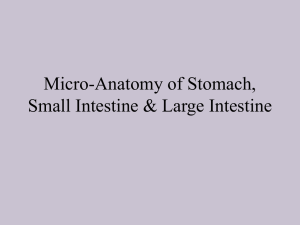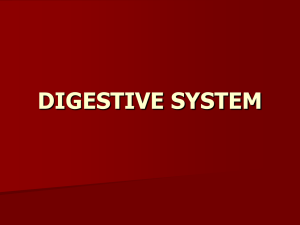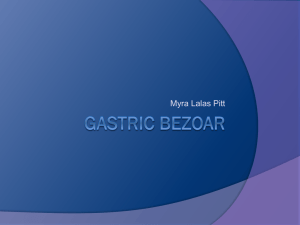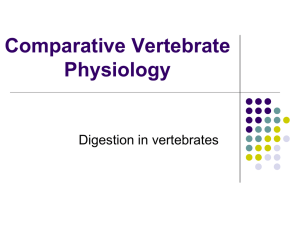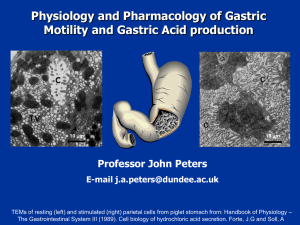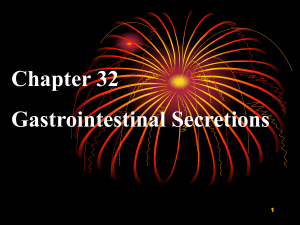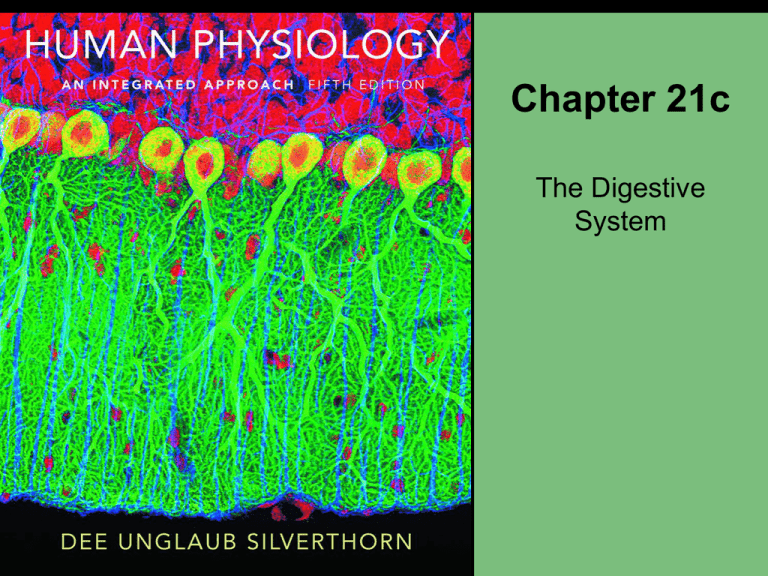
Chapter 21c
The Digestive
System
The Cephalic Phase
• Chemical and mechanical digestion begins in
the mouth
• Salivary secretion is under autonomic control
• Softens and lubricates food
• Chemical digestion: Salivary amylase and
some lipase
• Saliva also has a protective function
• Chewing: mastication
Swallowing Reflex
1 Tongue pushes bolus against soft
palate and back of mouth, triggering
swallowing reflex.
Soft palate
Hard palate
Tongue
Bolus
Epiglottis
Glottis
Larynx
Tonically contracted upper
esophageal sphincter
Figure 21-24, step 1
Swallowing Reflex
2 Upper esophageal sphincter relaxes
while epiglottis closes to keep
swallowed material out of the airways.
Epiglottis
Figure 21-24, step 2
Swallowing Reflex
3 Food moves downward into the
esophagus, propelled by peristaltic
waves and aided by gravity.
Figure 21-24, step 3
The Gastric Phase
• Storage
• Stomach
• Digestion
• Stomach
• Acid, enzymes, and signal molecules
• Protection
The Gastric Phase
• Activity of secretory cells of the gastric
mucosa
Gastric mucosa
Cell Types
Substance Secreted Stimulus for Release
Mucus
Opening
of gastric
gland
Mucous
neck cell
Bicarbonate
Tonic secretion;
with irritation of
mucosa
Secreted with
mucus
Gastric acid (HCl)
Parietal
cells
Intrinsic factor
EnterochromaffinHistamine
like cell
D cells
G cells
Physical barrier between
lumen and epithelium
Buffers gastric acid to
prevent damage to
epithelium
Activates pepsin;
kills bacteria
Complexes with vitamin
B12 to permit absorption
Acetylcholine,
gastrin
Stimulates gastric
acid secretion
Digests proteins
Gastric lipase
Acetylcholine; acid,
secretin
Somatostatin
Acid in the stomach
Inhibits gastric acid
secretion
Gastrin
Acetylcholine,
peptides
and amino acids
Stimulates gastric
acid secretion
Pepsin(ogen)
Chief cells
Acetylcholine,
gastrin, histamine
Function of Secretion
Digests fats
Figure 21-25
The Gastric Phase
• Integration of cephalic and gastric phase
secretion in the stomach
1
1
Food
Input via
vagus nerve
Gastric mucosa
Lumen of
stomach
Amino acids
or peptides
G cell
+
D cell
2 Gastrin stimulates acid
secretion by direct action
on parietal cells or indirectly
through histamine.
Gastrin
2
3 Acid stimulates short reflex
secretion of pepsinogen.
Somatostatin
4
Negative feedback
pathway
Histamine
4 Somatostatin release by H+
is the negative feedback
signal that modulates acid
and pepsin release.
ECL
cell
Parietal
cell
H+
3
Pepsin
1 Food or cephalic reflexes
initiate gastric secretion.
Enteric
sensory
neuron
Pepsinogen
Enteric
sensory
neuron
Enteric
plexus
Chief
cell
Figure 21-26
The Gastric Phase
1
1
Food
Input via
vagus nerve
Gastric mucosa
Lumen of
stomach
Amino acids
or peptides
1
Enteric
sensory
neuron
Food or cephalic reflexes
initiate gastric secretion.
G cell
Gastrin
Enteric
plexus
Figure 21-26, step 1
The Gastric Phase
1
1
Food
Input via
vagus nerve
Gastric mucosa
Lumen of
stomach
Amino acids
or peptides
G cell
Gastrin
2
Histamine
H+
1
Food or cephalic reflexes
initiate gastric secretion.
2
Gastrin stimulates acid
secretion by direct action
on parietal cells or indirectly
through histamine.
Enteric
sensory
neuron
ECL
cell
Parietal
cell
Enteric
plexus
Figure 21-26, steps 1–2
The Gastric Phase
1
1
Food
Input via
vagus nerve
Gastric mucosa
Lumen of
stomach
1
Food or cephalic reflexes
initiate gastric secretion.
2
Gastrin stimulates acid
secretion by direct action
on parietal cells or indirectly
through histamine.
3
Acid stimulates short reflex
secretion of pepsinogen.
Enteric
sensory
neuron
Amino acids
or peptides
G cell
Gastrin
2
Histamine
Parietal
cell
H+
3
Pepsin
ECL
cell
Pepsinogen
Enteric
sensory
neuron
Enteric
plexus
Chief
cell
Figure 21-26, steps 1–3
The Gastric Phase
1
1
Food
Input via
vagus nerve
Gastric mucosa
Lumen of
stomach
1
Food or cephalic reflexes
initiate gastric secretion.
2
Gastrin stimulates acid
secretion by direct action
on parietal cells or indirectly
through histamine.
3
Acid stimulates short reflex
secretion of pepsinogen.
4
Somatostatin release by H+
is the negative feedback
signal that modulates acid
and pepsin release.
Enteric
sensory
neuron
Amino acids
or peptides
G cell
Gastrin
2
+
D cell
Somatostatin
4
Negative feedback
pathway
Histamine
Parietal
cell
H+
3
Pepsin
ECL
cell
Pepsinogen
Enteric
sensory
neuron
Enteric
plexus
Chief
cell
Figure 21-26, steps 1–4
The Gastric Phase
• The mucus-bicarbonate barrier of the gastric
mucosa
Stomach
lumen
Gastric juice pH ~ 2
The mucus layer is a physical barrier.
HCO3– Bicarbonate is a chemical HCO3–
barrier that neutralizes acid.
pH ~ 7 at cell surface
Mucus
layer
Mucus
droplets
Gastric
mucous
cell
Capillary
Figure 21-27
Reflexes of Cephalic and Gastric Phases
• Long and short reflexes of the cephalic and
gastric phases of digestion
Figure 12-23
The Intestinal Phase
• Chyme in the small intestine inhibits gastric
motility and secretion
Food
into
stomach
Acid secretion
STOMACH
Pepsin and lipase secretion
Gastric motility
Chyme
into small
intestine
SMALL
INTESTINE
Hyperosmotic
solution
? Endocrine
cell
PANCREAS
Carbohydrates
GIP
GLP-1
Insulin
secretion
Enteric
nervous
system
Fats,
proteins
Acid
CCK
Secretin
Pancreatic
enzyme
secretion
Pancreatic
bicarbonate
secretion
Figure 21-28
The Intestinal Phase
• Bicarbonate neutralizes gastric acid
• Goblet cells secrete mucus for protection and
lubrication
• Bile
• Fat digestion
• Digestive enzymes
• Enteropeptidase
The Intestinal Phase
• Activation of pancreatic zymogens
Lumen of small intestine
Pancreatic duct
Pancreatic secretions
(include inactive
zymogens)
Trypsinogen
ZYMOGENS
• Chymotrypsinogen
• Procarboxypeptidase
• Procolipase
• Prophospholipase
Enteropeptidase
in brush border
activates trypsin.
Trypsin
activates
ACTIVATED ENZYMES
• Chymotrypsin
• Carboxypeptidase
• Colipase
• Phospholipase
Intestinal
mucosa
Figure 21-29
Hepatic Portal System
• Most fluid is absorbed in the small intestine
Aorta
Capillaries
of liver
Hepatic
vein
Inferior
vena cava
Liver
Hepatic artery
Capillaries of digestive
tract: stomach, intestines,
pancreas, and spleen
Hepatic
portal vein
Digestive
tract arteries
Figure 21-30
The Intestinal Phase
• Most digestion occurs in small intestine
• Large intestine concentrates waste for
excretion
• Motility in large intestine
• Mass movement triggers defecation
• Defecation reflex
• Digestion and absorption in large intestine
• Diarrhea can cause dehydration
The Intestinal Phase: Anatomy of the Large Intestine
Hepatic portal vein
Aorta
Tenia coli
Lymphoid
nodule
Intestinal
glands
Inferior vena cava
Transverse colon
Muscularis mucosae
Submucosa
Ascending
colon
Descending
colon
Ileocecal valve
Ileum
Longitudinal layer
(tenia coli)
Circular muscle
Muscularis
externa
Haustra
Cecum
Sigmoid colon
Appendix
Rectum
Rectum
Internal anal sphincter
External anal sphincter
Anus
Figure 21-31
The Intestinal Phase: Anatomy of the Large Intestine
Figure 21-31 (1 of 3)
The Intestinal Phase: Anatomy of the Large Intestine
Figure 21-31 (2 of 3)
The Intestinal Phase: Anatomy of the Large Intestine
Figure 21-31 (3 of 3)
Immune Function
• M cells sample the contents of the gut
• Immune cells secrete cytokines
• Cytokines trigger inflammatory response
• Increase in Cl–, fluid, and mucus secretion
• Vomiting is a protective reflex
Summary
• Function and processes
• Digestion, absorption, motility, secretion, and
GALT
• Anatomy
• Motility
• Tonic and phasic contractions
• Slow wave potentials, interstitial cells of Cajal,
migrating motor complex, peristaltic
contractions, and segmental contractions
Summary
• Secretion
• Parietal cells, CFTR chloride channel, mucous
cells, goblet cells, saliva, and bile salts
• Regulation
• Short reflexes, ENS, long reflexes, intrinsic
neurons, gastrin family, secretin family, and
other hormones
Summary
• Digestion and absorption
• Amylase, disaccharidases, endopeptidases,
exopeptidases, lipase, colipase, micelles,
chylomicrons, and intrinsic factor
• The cephalic phase
• The gastric phase
• Mucous cells, chief cells, D cells, ECL cells, and
G cells
Summary
• The intestinal phase
• Brush border, mass movement, and defecation
reflex
• Immune functions
• M cells and vomiting


